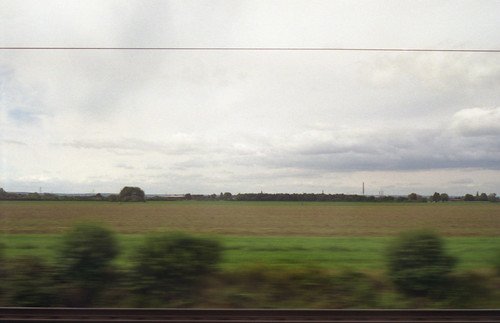
Travel by railway features in all three films of Wim Wenders' road movies trilogy, but only in Falsche Bewegung (Wrong Move) is it instrumental in developing the narrative. Both Alice in the Cities and Kings of the Road end with characters taking trains in different forms of open resolution, while the section in Alice in the Cities in which the characters use the Schwebebahn functions more as a brief stasis in the narrative than actively furthering their search. Wilhelm's journey south by train in Wrong Move is the beginning of his story; here he is thrown together with Mignon and Laertes, or rather, they attach themselves to Wilhelm, Laertes obliging Wilhelm to pick up the cost of their tickets. On the platform of Hamburg station, changing trains, Therese looks up from her magazine into Wilhelm’s compartment, and then, getting on a different train, holds Wilhelm’s gaze as the two trains move in parallel for a number of minutes, before Wilhelm's train slows, stops, and begins to move backwards.
Last month, returning by train from Kassel, I rejoined Wilhelm's route from Hamburg to Bonn, which I had broken last year to travel to Gelsenkirchen, to find Alice's grandmother's house. August in Germany was bright, hot, and arriving in Bonn by train at midday felt far from the autumnal feel of Wrong Move: although Wenders describes the filming of Wrong Move as having taken place in the summer of 1974, the shoot must have begun at the end of summer, judging by the conditions depicted, and continued into the start of autumn, while a good deal of the filming was done at the ‘blue hour’, just after sunset, adding to its peculiar atmosphere.
Although Wilhelm encounters Mignon and Laertes on the train to Hamburg Altona, he only really meets them on the train from Hamburg to Bonn: sitting opposite Wilhelm, before the train leaves the station, observing his gaze toward Therese, Laertes finally talks. Without any preamble he states: “That woman who made you so full of longing is Therese Farner. She’s an actress.” The actress Therese is played by the actress Hanna Schygulla, a regular in Fassbinder’s repertory; years before Wrong Move, (and before he had established himself as a director) Wenders had singled her out in an otherwise negative review of Fassbinder’s Katzelmacher: "In this dead film, only Hanna Schygulla looks so alive that you think you're watching her in colour." For her first appearance in Wrong Move perhaps it’s appropriate that Wenders was content to let Wilhelm - and the viewer - simply watch Schygulla’s face in this long sequence of parallel movement. Laertes then explains that he gets nosebleeds from remembering, referencing the blood of St Januarius. Interrupted by the conductor entering the compartment with a story of forgetting his umbrella and the realisation that he had put odd socks on in the morning, the conductor salutes Laertes once the tickets have been bought. Laertes tells Mignon to thank Wilhelm for the tickets. Mignon demonstrates some tricks: juggling, balancing on her head, walking on her hands, pickpocketing Wilhelm while Laertes plays the mouth organ; Wilhelm sticks his head out of the carriage window into the onrushing air and the shot is framed so that we see the train curving behind him into the distance.
In the dining car, Wim Wenders himself makes a cameo appearance as a diner with his back to the camera as Wilhelm enters. Joined by his companions, Laertes passes a note from the conductor to Wilhelm which reads, "Carriage 83, compartment 3 (window seat)" and has a phone number attached. Laertes here refers to the conductor by name, Eichinger, which, retrospectively, adds a conspiratorial undercurrent - not only in the business of getting Wilhelm to pay for their tickets, but with his salute, suggestive that the two may have known each other from the war, although this is entirely underplayed and inferred. That the conductor salutes with punctiliousness, and that Laertes’ salute in reply is casual, offhand, implies the relative ranks of the two. Wilhelm there remarks, “I remember that old salute from the movie newsreels.” There follows a shot of the conductor looking in on the dining car; the actor, Adolph Hansen, would later reprise this role in The American Friend. The train sequences of Wrong Move end with a cut to a static shot of a station clock, high above a platform, showing 4 o’clock, as a train speeds past, the colour of the sky indicating a late afternoon or early evening light; as the second hand on the clock reaches the twelve o’clock position, it appears to stop there, briefly motionless before this shot itself is cut.
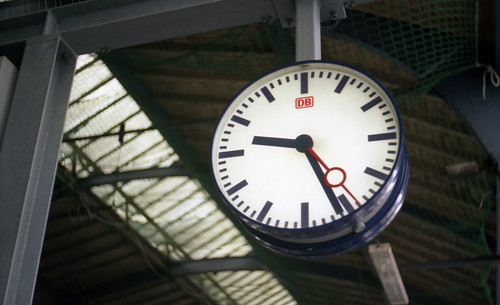
Patrick Keiller, in ‘Phantom Rides: The Railway and Early Film’, draws out the parallels between the technology of cinema and the railway, and highlights one particular pre-cinematic technology that developed alongside the railway, the moving panorama. Famously seen in Max Ophüls’ film, Letter From An Unknown Woman, set around 1900, the moving panorama often mimicked the experience of being seated in a railway carriage, with the painted scenery travelling past the viewer, unlike the static panorama, taking the form of a 360-degree painting, in which the viewer has to move to experience the entirety of the spectacle. Keiller links the moving panorama to the first films in which the camera moves, being placed on trains, trams, and boats, and initially recording the passing view as a panorama, before being superseded by the phantom ride, with the camera placed at the front of the vehicle. Rudolf Arnheim, writing in 1933, referring back to the moving panorama, describes how, once the motion picture camera was developed, “travelling shots of landscapes were not at all obvious but had to be invented all over again, as it were,” and, while Keiller’s essay does not acknowledge Arnheim, clearly for both writers, a fundamental expression of modernity is here coming into being. The earliest moving images in the 1890s utilised a static camera; the first recorded use of a travelling shot was made by Alexandre Promio (referenced by Keiller, and directly quoted by Arnheim); the idea came to him as he arrived in Venice by boat in 1896, experiencing a scene very much like the moving panorama: “When I saw the buildings along the Grand Canal move by, I had the idea that the film camera, which could take pictures of moving things while it was standing still, perhaps could take immobile things while it was moving itself. I took a sample film and sent it to Mr. Louis Lumière, asking him for his opinion. The reaction was positive.”
In attempting to describe a prehistory of the European road movie, Wendy Everett lists the Lumière Brothers’ Arrival of a Train at La Ciotat Station as belonging to the origins of the genre, “the first film to bring together the new and much fêted medium of cinema with other, closely related, modernist notions of movement, speed, and travel”. Certainly, the Lumière’s first films from 1895 are full of arrivals and departures: their workers leaving the Lumière factory (in at least three versions); the arrival of the deputies at the photographic congress in Lyon, and, of course, the famous train arriving. Promio, working for the Lumière company, travelled widely during 1896 and 1897, through Europe, Russia, Palestine, Turkey and Egypt, and Keiller details a number of railway panoramas Promio shot in 1897, following his film of Venice. Cinematic genres, by necessity, are defined retrospectively through an existing body of films, and, although journey narratives have featured throughout the history of cinema, the road movie as a distinct form emerges as a “post-war phenomenon,” as Everett quotes Timothy Corrigan (writing in 1991), a phenomenon coming of age in the 1960s - and a key text for the archetypal road movie is Kerouac’s novel On The Road (the overlap of this definition of the road movie with the male ‘buddy’ film is also pertinent as a lens through which the genre is focussed). This codification of the road movie as a distinctive American post-war genre, creates a limiting definition which excludes both earlier films with journey narratives, and with other cinemas becoming a reflection of the American model. A number of writers (Laderman, Everett, and Mazeierska and Rascaroli) ascribe one clear difference between American and European road movies: in the former, the protagonists are wedded to (and self-identify with) their own private motor vehicle, whether car, motorbike or truck; in the European road movie, by contrast, characters tend to travel by wider means of locomotion, including public transport; in addition, the reasons for going 'on the road' are often different. Notably, David Laderman asserts that in European road movies “traveling outside of society becomes less important (and perhaps less possible than traveling into the national culture, tracing the meaning of citizenship as a journey.” This is what Wilhelm is doing quite explicitly in Wrong Move - his journey is an exercise to experience his homeland and is designed to make him a writer. The cinematic landscape is also different, as Everett writes: “I am intrigued by a recurring image in American road movies: that of the open road vanishing into the horizon, with its promise of endless possibilities and journeys yet to come.” By contrast, in the European road movie, “we rarely see a vanishing point or horizon, instead we are faced with sharp bends in the road, with soul-destroying traffic jams, and with ambiguous, problematic crossroads, complete with illegible of missing signposts.” Travelling by train, a single-point perspective view to the horizon is lacking: the view out of the window for Wilhelm - at what is passing - constructs him as a passenger. The modes of transport throughout Wrong Move all appear to symbolise Wilhelm's lack of autonomy and volition (in leaving his home town, the train ticket to Bonn has been bought for him by his mother; later, it is Therese who drives Wilhelm and the other characters in her car). However, public transport is a shared common space, and the train carriage - and especially the dining car - are places where encounters can occur while moving, as happens to Wilhelm, rather than at transport nodes, stops or interchanges. In addition, as a passenger, Wilhelm’s reading of The Life of a Good-for-nothing for the duration of the first part of his railway journey enables Wenders, through his long dissolves, to collapse the external and internal narratives, expressing the idea of Wilhelm being engrossed in the book, being ‘somewhere else’, and, on reaching Hamburg Altona, the appearance of Laertes alongside Mignon comes to him as a surprise.
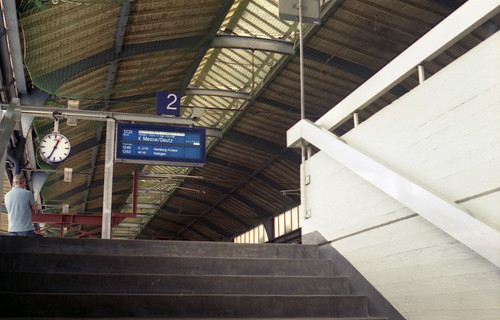
Cutting from the clock, a shot of the three characters on a platform shows an indicator in the background displaying the 19:27 Stuttgart train. In the Axiom DVD commentary, Wenders describes Bonn, the then capital of West Germany, as “a tiny provincial town, as you can see from its main station.” Peter Handke’s script had Wilhelm travel to Soest; Wenders used Bonn instead, the fact of it being the provincial capital adding a political inference to the location where all the main characters come together. After meeting Laertes and Mignon on the train to Bonn, he meets Therese there the next morning, and then the poet Bernhard later. After Bonn, the only other significant character that appears in Wrong Move is the industrialist - who doesn’t join the group, who does not travel with them. Bonn is also the first stop on Wilhelm’s general movement towards modernity, away from the Heimat of Glückstadt, to Therese's apartment (which, as she has just moved in, lacks the atmosphere of home) in the high-rise concrete suburbs of Frankfurt, post-war blocks crowned with neon signs. Descending some stairs at the station, Laertes stops to tie his shoelace at the top; Mignon holds Wilhelm back at the bottom to wait for him. They pass a woman selling some sort of tract in the subway under the tracks, then emerge from a parallel set of stairs by a sign, BONN HBF. In the street outside, illuminated signs fill the background - KLM, Hapag-Lloyd, Diplomat, 4711 Eau de Cologne, Lichtspiele, and the lights of traffic. Bonn Hauptbahnhof remains largely unchanged from when Wenders filmed there, though perhaps not for long. The subway has been tunnelled through at its far end, and the stairs that the characters emerge from have been replaced by an escalator, surrounded by building work when I photographed it, though the stairs down from platform 2 remain. Immediately outside, in a cinematic touch, the face of the Golem from the eponymous 1920 silent film, appeared, faded, pasted on a hoarding enclosing heavy machinery. The illuminated signs are gone.
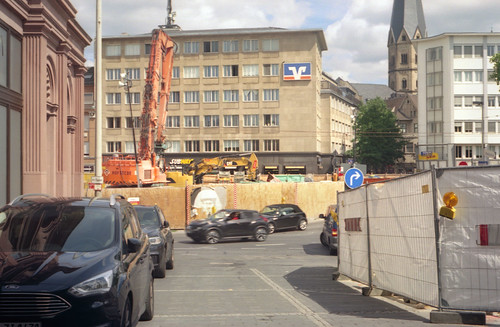
From the exterior of Bonn Hauptbahnhof, there is a cut to a shot of a hotel lobby, with keys in pigeon holes on the back wall. Laertes and Wilhelm are shown standing at the desk while Mignon sits on the floor. Wilhelm is filling out a form - he has already written in a stay of one night. Turning to Laertes he asks, ”What profession did you give?”
”I’m a singer. And her? She’s an artist.”
There is a return to the close up where the camera then shows Wilhelm write, “Schriftsteller” - writer.
The form that Wilhelm fills out provides the name of the hotel: Sternhotel. The Sternhotel still exists, located on Marktplatz in the centre of the city. It would have been an appropriate felicity to have stayed there for the one night I spent in Bonn, but the hotel was more expensive than my limited means allowed. In the his commentary to Wrong Move, Wenders remarks that the hotel appears in Machorka-Muff, the short film by Jean-Marie Straub and Danièle Huillet from 1963. Straub and Huillet’s film marked the beginning of the Young German Film which matured into the New German Cinema: according to Eric Rentschler, Machorka-Muff was “one of Young German Film’s earliest signs of life,” notable, specifically, for Retschler, in the way that the film deals with the politics of remembering for the new democratic German state. Wenders was not aware that Machorka-Muff was filmed there at the time he chose the Sternhotel for Wrong Move, but, while filming, recognised the hotel with a feeling of deja-vu, and there are of course elements of remembering that haunt Wenders’ film, Laertes’ blood being the clearest visual symbol; coincidentally, another work by Straub and Huillet, Chronik der Anna Magdalena Bach (The Chronicle of Anna Magdalena Bach, 1968), happens to be playing on a television later in Wenders’ Wrong Move.
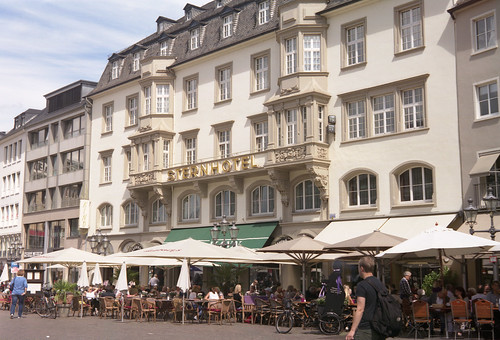
Inside Wilhelm’s hotel room, Wenders constructs a scene comprising a single shot as the camera tracks Wilhelm’s movements, from closing the door by putting the weight of his back against it, to picking up the phone, asking for the number in the note from the conductor, putting the receiver down, then panning away from Wilhelm as he moves to the window, out to the market square outside, with noises coming up from the traders below as a church bell rings, Wilhelm moving back into the frame at the window with a focus shift; the telephone rings and the camera returns with Wilhelm into the room as he sits on the bed, facing the phone as a fade to black begins before we see him pick up the receiver. This long shot is accompanied by a voiceover.
“Seeing that woman this afternoon on the train seemed adventure enough for me. I thought I’d regret it for the rest of my life if I didn’t pursue it. [A grosses Arbentur in German, a great or big adventure, adventure in the sense of its future promise.] But now in this hotel room, with its feather bed, plastic wastepaper basket and neon light over the sink, I was as deflated as my surroundings. I was practising what I would say in the phone. For example, ‘I’m dying to see you.’ I decided to shake off the urge and not start blabbing. If she said nothing, I would say nothing too. I looked down onto the square. [The telephone rings.] All of a sudden I had the urge to write. It would take my mind off her. This thought dissipated my fear of a new person. I wanted to know her voice, which I hoped was like her gaze. Afterwards I’d write it down in detail.”Peter Handke’s screenplay was, according to Wenders, “practically without directorial notes and didn’t even specify locations. Handke’s text left me a lot of freedom, and in fact I didn’t change a word of his dialogue. After the filming was over, when we were looking at the film during editing, we added a voiceover that hadn’t originally been planned.” Intriguingly, if this was the case, Wenders’ Wrong Move without the voiceover as filmed, would have had long stretches free of words, concentrating on Wilhelm alone on screen for minutes at a time, without access to this interior voice. One presumes that this may also have included his reading Eichendorff’s novella in voiceover on the train.
An abrupt cut to Mignon’s face follows, with dialogue being spoken over it, swiftly cutting to Wilhelm who is speaking about not dreaming for two nights, not cutting his nails for a week, wearing the same shoes for a month, not thinking about dying for years, imagining the world going on without him. As the camera moves back from the close-up of Wilhelm’s face, we see he is reading at a breakfast table in the hotel, and when he finishes he asks Laertes if he can make a song from it, tearing out the page from his book to pass to him. A figure in the background of this scene is listening intently to the conversation: Bernhard Landau - who we do not yet know - but like the introduction of Laertes, first appearing as an incidental figure brushing past Wilhelm as he gets on train at Glückstadt, Bernhard is revealed retrospectively. Bernhard becomes important as a means to get the group to the industrialist’s house, which he mistakes for his uncle’s, after they leave Bonn. Laertes says that he will tell Wilhelm his story later, but for now, as a “hint”, states: ”I ran in the 1936 Olympics. The 100 metres.” Mignon is shown with fingers in her ears as Laertes talks. Wilhelm retorts “And you wouldn’t shake hands with Jesse Owens, like your Führer.” Laertes replies that he didn’t reach the finals but states that he would not have done so then anyway. Wilhelm asks, “Und jetzt?” - “And now?” (the subtitles on the Axiom DVD of Wrong Move render this as “What now?”, which makes little sense as a rejoinder) to which Laertes does not answer. This atmosphere is broken by Wilhelm saying that they had better go for a walk, and the two get up just as Bernhard turns to Wilhelm with a look of apprehension. Wilhelm and Laertes depart, with Mignon remaining seated for a moment, juggling and dropping bread rolls from the table. Bernhard attempts to help to pick these up as Mignon herself then leaves.
Richard W. McCormick, in a footnote on Laertes’ name (Wilhelm only refers to him as “the old man” in the film itself; the name Laertes appears in the on-screen credits), referring to the father of the wandering Odysseus, describes Wilhelm as roaming Germany “in search of an identity, finds Laertes, and sees in him a father figure he would like to kill-an appropriate reading for the intergenerational tensions in the film with regard to Germany’s past.” McCormick does not expand his reference of Laertes’ name to include both the character from Goethe’s Wilhelm Meister Lehrjahre, which inspired Handke’s script, or the Shakespeare that in turn inspired Goethe. Laertes, in Wilhelm Meister, fulfils a guiding role to Wilhelm as the latter embarks upon a career as a travelling actor; here, he represents distrust of the older generation, with all that implies for someone like Wilhelm (and Wenders) born at the end of the war. The film seems to suggest that this Laertes is emblematic of his generation, that, despite accompanying Wilhelm across Germany, no guidance is possible, with an ever-present undercurrent of suspicion of the necessary complicity involved with simply surviving the war (and the post-war silence seen as necessary for building the new democratic state). This complicity is implied in the conspiratorial manner which Laertes indulges the conductor on the train; as played by Hans Christian Blech, Laertes frequently meets Wilhelm’s questions with an ironic smirk, as if asking, well what would you have done?
One function of the road movie is to provide the means for social critique through traversing a territory, with its protagonists often positioned as outsiders to emphasise this; Bennet Schaber writes of the road movie as discovering or inventing the ‘image of the people‘ - “To be on the road is to be in the presence of the people. […] The image of the people, then, is pregnant with its own political arrival.” For Schaber, pre-war road films from Hollywood, coming out of the studios’ responses to the Depression and then, subsequently, the war itself, by necessity stressed community as something to be encountered on the road, usually through the eyes of a character removed from ‘the people’ through wealth and fame (examples of this would be films such as It Happened One Night and Sullivan’s Travels). However, after the war, and writing specifically about directors such as Wim Wenders and Jim Jarmusch, Schaber finds “…post-war films, predominately although not exclusively products of American and European cinema, deployed the road experimentally, as it were, with the result being various practices of images both of and in the absences of the people,” and that, “…more often than not, these later films found only images of the absence of the people, of the people as memory or yet to come.” Applied to Wrong Move as an ‘image of the people’ of post-war West Germany, stuck between memory and the ‘yet to come’, there is something unresolved, irreconcilable. In the film the characters come together around Wilhelm only then to spin apart, with the exception of Mignon, whose care is entrusted to Therese at the end of the film, transferred from Laertes through Wilhelm. A difficult character to accommodate, Laertes perhaps represents the fact that McCormick’s “intergenerational tensions” could only be resolved by that generation dying out, or, at the very least, leaving the stage of public life: indeed, although Laertes appears a marginal, itinerant figure, living off his wits and exploiting others, he is yet a haunting figure for the new Germany a generation after the war.
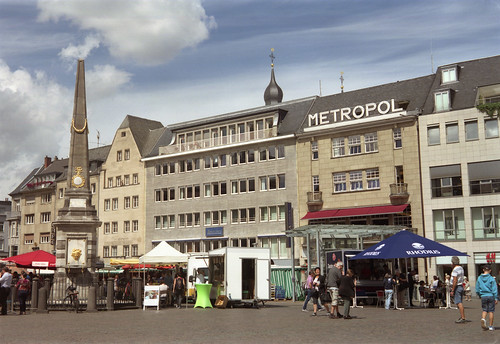
Outside, Wilhelm and Laertes are seen walking together, their breath in the air as they speak. "I intend to start writing today but I dreamt so much in the night it’s now impossible to write about anything else. And just writing about dreams is... I'd like to be able to write something essential." Stopping, Wilhelm looks over to a car (parked in front of the hotel itself) to see Therese getting out. They meet in a mannered embrace, theatrical, artificial, with a sense of mirroring in the fact that both wear raincoats; in the near background is a camera on a tripod between them as they come together. Off screen, a whistle is followed by a shout, in English with an American accent, “Hey! Get outta there! Get out of range of my camera!” The two turn to the camera as the distinct noise of a mechanical self-timer can heard running down before the shutter trips. A cut shows a couple on the steps of the town hall in the middle distance, waving in a not unfriendly manner. Perhaps this brief interruption can be seen as contrasting different types of travellers, the foreign tourists who desire an image of themselves in front of a recognised landmark against Wilhelm’s journey to discover a different kind of Germany, although I find common assumptions about a typical touristic experience of place as being ‘inauthentic’ problematic, and this may not be what is represented here. It does function, however, as an auspicious idea that Wilhelm and Therese’s meeting is captured on a chance photograph. Immediately behind the two as they meet, a cinema hoarding announces Coppola’s The Conversation ('Gene Hackman in Der Dialog') and a film titled, 'Zwei Wie Pech Und Schwefel', a literal translation would be 'Two thick as thieves' (it was released in English as Watch Out, We're Mad). As in Glückstadt, the film titles, although incidental, can be seen as commenting on the action taking place in the foreground. The Metropol in the far background can also just be made out, showing ‘Emanuela’ (Emmanuelle), “Ein Erotisches Meisterwerk.” All films seen in the background were current, all being released in 1974.
The presence of all these small cinemas (a drive-in cinema later features, and the sign for a cinema can be just glimpsed opposite the station when the characters alight at Bonn) are redolent of a time before ‘home entertainment’; before video, while television challenged cinema yet there was still evidentially a sufficient if shrinking audience to support numerous small town cinemas (there’s no cinema in Glückstadt at the time of writing; there had been another cinema, separate from the one which was located below Wilhelm’s apartment, which closed in recent years). These small town cinemas would inspire Wenders’ next film, Kings of the Road. Forty-three years later, on Markplatz in Bonn in the same building that houses the Sternhotel, there is still a cinema there where The Conversation had been playing in the summer of 1974; no longer with a hoarding above its twin arches announcing its screenings, when I was there a large cut out figure in the lobby pointed to one of the Despicable Me films. This title could have been used to comment on Wrong Move's protagonist, although despicable is too strong to describe the self-interested, morose Wilhelm. The cinema under the Metropol has gone.
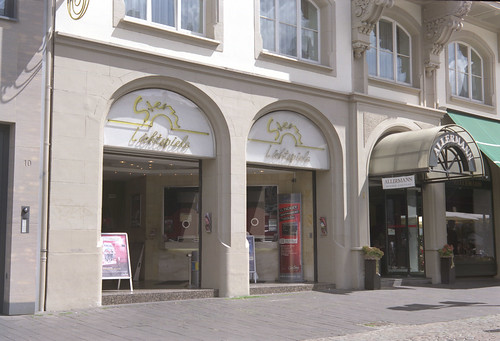
Therese says that she felt like going for a walk with Wilhelm as she was driving, and arriving back at her car, Laertes is sitting on the car bonnet and replies, “We were just doing that.” Bernhard is seen in the background, fiddling with his hair, not part of the group yet. Mignon slams Therese’s car door in a demonstrative way. Wilhelm shrugs. There’s a brief shot of Wilhelm and Therese walking past shops, then, in a crowded square, Mignon is seen doing cartwheels for change, Laertes playing the mouth organ again; here, Bernhard appears for the first time in a shot on his own, eating nuts from a street vendor. Laertes looks at a piece of paper which may be Wilhelm’s ‘poem’ from breakfast. Wilhelm and Therese turn to walk down a side street. Therese asks, ”Would you like to be alone with me?”
“Not now. It’s good… [there’s background noise as they pass a loading bay] It's good that we have company, otherwise it would be worse." Bernhard follows at a distance, while Mignon gives Laertes the change she has collected.
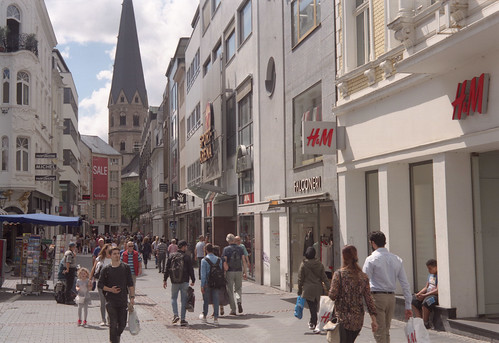
This becomes the first of two significant walking sequences in the film; the second walk, on a hillside above the Rhine, concerns the interactions between the characters as a group while they walk, combining and splitting into different pairs, a masterful demonstration of mobile choreography, the set piece of the whole film. This walk in the back streets of Bonn constructs the group largely as observers of the provincial capital city; despite its provinciality, and the apparent quietness of those back streets, the city remains a place for encounters, though these encounters produce a sense of the characters as mere observers unable or unwilling to act (which Wilhelm later embodies more explicitly in his unfulfilled threat to Laertes). Three notable incidents on this walk emphasise the anomie and anonymity of the city, each perhaps has an element of the absurd, each undermining the idea of a walk as something undertaken for pleasure.
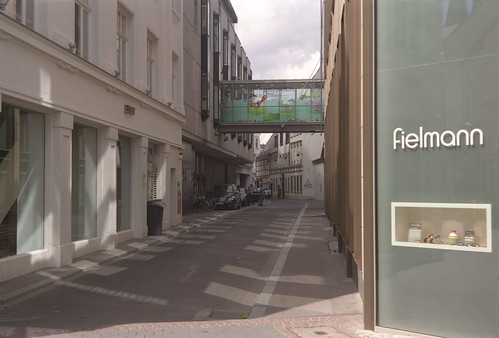
I had intended to follow this first walk in Bonn. With this sequence beginning in Markplatz, outside the Sternhotel and the cinema, it starts in pedestrianised areas, which are harder to track online with Street View. Remigiusplatz, where Mignon turns cartwheels, was easy to identify by the presence of the Bonner Münster church in the background; this can be seen from Markplatz itself along the short side street which connects the two squares. The characters then take another side street, with the evocative name of Mauspfad (mouse-path), away from the bustle of Remigiusplatz. This street’s character has changed a little since the film: the supermarket that was on the corner is now a clothes shop, and a glass-walled bridge connects buildings on both sides above the road; although most of the buildings have been reclad, the loading bay is still there, behind the panels of a long metal grill. Mauspfad ends at a triangular open space, named, appropriately, Dreieck. This is where the film breaks from the geography of the city; there is also no dialogue or voiceover for the rest of this section of the walk. The group appear to have turned right into another narrow street. In the background across the end of the street is a blank wall with a series of posters that look as though they might belong to a supermarket. Wilhelm and Therese arrive at a road, and, waiting to cross, Laertes and Mignon catch up; Bernhard hangs back, pretending to look in a window. Crossing the road after some cars pass, takes them into an alley, where, at the sound of a baby crying, they stop to look up. Continuing, past a bend in the alley, with the camera now behind the group, they stop, turn around and look up again (this shot was used for the Axiom DVD cover, cutting out Laertes, and made black and white). From below, we see a couple fighting on balcony, struggling violently, yet the group appear to barely react to this scene. The third incident of this walk shows the group’s attention briefly arrested by a man shouting out of window at them: "Do you have any idea what pain is? Do you swines know how the rushing of a sail plane sounds when it's in your brain?" This has an echo in a later film by Wenders, in the scene in Paris, Texas with the 'screaming man' ("There will be no safety zone") which Travis meets on the freeway bridge, but in that film there is a sense of fraternal sympathy expressed by Travis in his gesture of gently laying a hand on the man’s back as he passes. In Wrong Move, the characters are separated from the man in the window by a distance and can only look on, unanswering.
This section ends with Therese breaking into a run, then Mignon, and the rest of the group following, Laertes pointing the way, directing them to a street to the left. Bernhard runs after to keep up, briefly stalling as they turn to the left. The camera follows his viewpoint along the alley as he disappears after the group; the camera continues to move slowly forwards for just a few seconds at the point when none of the characters remain on the screen. Incidentally, the travelling shots during this walk were photographed from a Renault R4 being pushed by the crew, as seen in the ‘making of’ super 8 footage (and another R4 is seen parked in the alley where the characters disappear off screen), as was the second walking sequence from the film; in the commentary, Wim Wenders remarks that the Steadicam had yet to be been invented when Wrong Move was filmed, and indeed, it appeared the following year, 1975.
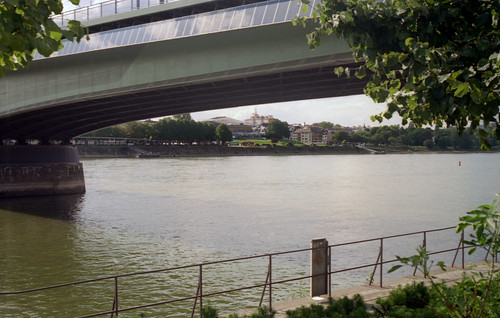
The final location at the end of their walk was easy to identify: the group come to sit on a terrace beside the river, close to a large bridge, the Kennedybrücke. In the background, the presence of Bonn’s Beethovenhalle on the far side of the river orients the group as being on the east bank of the Rhine just south of the bridge (the appearance of the Rhine then dictates the route of Wilhelm’s North to South journey for the remainder of the film); Marktplatz, Remigiusplatz and Mauspfad are all to the west of the river. The light in this scene is clearly late afternoon. Laertes taps on the windows of the dilapidated building, of which the terrace is part, commenting that he doesn’t think they’ll get any service here; when I found the building, a restaurant named Rheinlust, the terrace was busy, full. Attempting to work backwards from the Rheinlust and the Kennedybrücke to complete the route of the walk, I did find some timber-framed buildings nearby, in the vicinity of Agnesstrasse and Feldstrasse, but neither of these areas matched up to the backstreet and alleyway in which that part of the walk was filmed. At the end of the sequence that I couldn’t locate, there is a tantalising detail in the distance of a tower on a hill, which suggests that this sequence was filmed on the east side of the river, looking south at the end of the alleyway, but there’s nothing more secure to locate it. After much walking around under a hot sun, I abandoned my search.
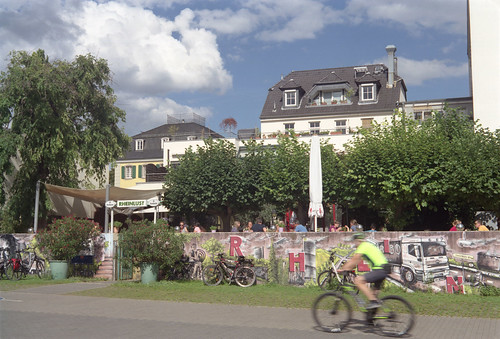
Although not immediately apparent on first viewing the film, there are clearly elisions of a number of hours between the characters starting their walk, seemingly straight after breakfast, their breath visible in the air, then walking through the back streets of Bonn, and arriving at the river in the late afternoon. This walk can be divided in five distinct sections, the first three all close spatially and, one would imagine therefore, temporally: meeting Therese and beginning at Markplatz; Mignon’s cartwheels in Remiguisplatz; the walk along Mauspfad; then the location I haven’t been able to identify, which features no dialogue; and finally ending at Rheinlust, where Bernhard introduces himself. In my previous investigations of the locations used for Alice in the Cities, but also The American Friend, I found that Wenders displays a certain fidelity to his locations in his films of the 1970s, especially in set-piece scenes, such as the first murder in The American Friend, which is still possible to trace through the Paris Metro and RER; although for most film-makers it would be unremarkable simply to choose a number of locations to create an on-screen continuity and ignore geographic contiguity, it feels uncharacteristic of Wenders in this sequence that these gaps in time and space are not alluded to by some filmic convention, but are presented as such a continuity. On the railway journey earlier in Wrong Move, the long dissolves suggest a fluid feeling of time passing as Wilhelm reads; there is also a fade to black in the change of scene to the dining car, while the static shot of the railway clock exterior to the train as it passes functions to announce the end of this sequence - as well as being an obvious allusion to time passing itself. Being unable to bring together the dislocations of this walk in Wrong Move, I was frustrated in not finding the alleyway, these gaps being unexpected for being not clearly acknowledged in the film. There is perhaps a recognition of the last spatial and temporal ellipsis on the walk however: as well as the change in light signifying a change in the time of day, the film itself in the first shot of this scene by the river begins in slow motion. This shows Mignon skipping up the stairs to the terrace ahead of the group, and then the film runs up to normal speed as the rest follow her. There is a fade to black from this scene, and then the film cuts to a car driving, with the Rhine just visible to one side, at sunset, with gold and purple clouds, reminiscent of Caspar David Friedrich.
The next day, I left Bonn by train. After a number of hot, sunny days it had begun to rain during the night, which continued through the day, traveling back through Cologne to Brussels and London, lending an autumnal feel to the landscape passing outside the train windows.
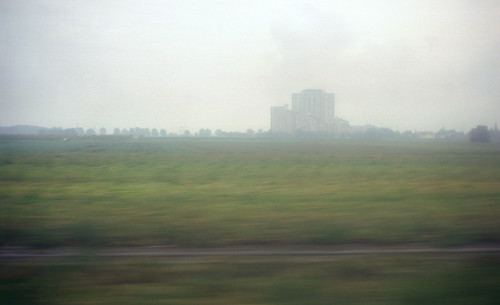
Bibliography
Rudolf Arnheim, ‘The Thoughts that made the Picture Move’, in Film As Art, Faber and Faber, London, 1958
Wendy Everett, ‘Lost in Transition? The European Road Movie, or A Genre “Adrift in the Cosmos”’, Literature-Film Quarterly, 37:3 2009
Johann Wolfgang von Goethe, Wilhelm Meister’s Lehrjahre, translated by Thomas Carlyle, 1795
Patrick Keiller, ‘Phantom Rides: The Railway and Early Film’ in The View From The Train, Verso, London 2013
David Laderman, Driving visions: Exploring the Road Movie, University of Texas Press, Austin 2002
Ewa Mazierska and Laura Rascaroli, Crossing New Europe: Postmodern Travel and the European Road Movie, Wallflower Press, London 2006
Richard W. McCormick, ‘The Writer in Film: Wrong Move’, in The Cinema of Wim Wenders: Image, Narrative and the Post Modern Condition, Roger F. Cook and Gerd Gemünden (editors), Wayne State University Press, 1997
Luke McKernan, ‘Who’s Who of Victorian Cinema’ (revised October 2008), http://www.victorian-cinema.net/promio - retrieved 20/9/17
Rentschler, Eric, The Use and Abuse of Cinema: German Legacies from the Weimar Era to the Present, Columbia University Press, New York, 2015
Bennet Schaber, ‘“Hitler can’t keep ‘em that long” The Road, the People’, in Steven Cohan and Ina Rae Hark (eds.), The Road Movie Book, Routledge, London 1997
Wim Wenders, Emotion Pictures, and The Logic Of Images; Essays and Conversations, Faber and Faber, London 1991
See also general bibliography
No comments:
Post a Comment